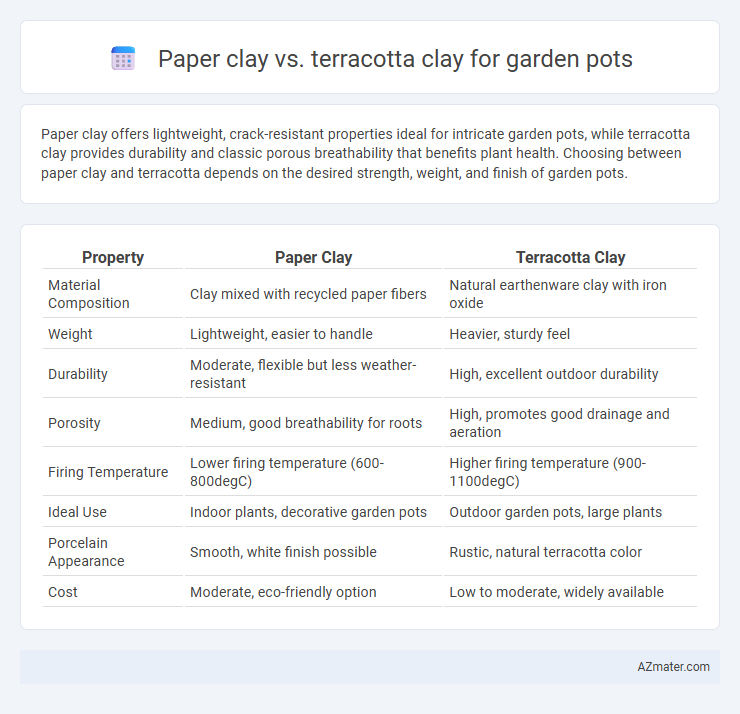Paper clay offers lightweight, crack-resistant properties ideal for intricate garden pots, while terracotta clay provides durability and classic porous breathability that benefits plant health. Choosing between paper clay and terracotta depends on the desired strength, weight, and finish of garden pots.
Table of Comparison
| Property | Paper Clay | Terracotta Clay |
|---|---|---|
| Material Composition | Clay mixed with recycled paper fibers | Natural earthenware clay with iron oxide |
| Weight | Lightweight, easier to handle | Heavier, sturdy feel |
| Durability | Moderate, flexible but less weather-resistant | High, excellent outdoor durability |
| Porosity | Medium, good breathability for roots | High, promotes good drainage and aeration |
| Firing Temperature | Lower firing temperature (600-800degC) | Higher firing temperature (900-1100degC) |
| Ideal Use | Indoor plants, decorative garden pots | Outdoor garden pots, large plants |
| Porcelain Appearance | Smooth, white finish possible | Rustic, natural terracotta color |
| Cost | Moderate, eco-friendly option | Low to moderate, widely available |
Understanding Paper Clay: Composition and Properties
Paper clay consists of traditional clay mixed with shredded paper pulp, enhancing its lightweight nature and improving drying strength, making it less prone to cracking compared to terracotta clay. This combination results in increased porosity and better insulation, which benefits plant roots by maintaining consistent moisture levels in garden pots. Unlike terracotta clay, which is denser and fired at higher temperatures for durability, paper clay offers a more flexible and eco-friendly alternative ideal for crafting delicate or decorative garden pots.
What is Terracotta Clay? Key Characteristics
Terracotta clay is a type of earthenware made from natural clay that is rich in iron, giving it a distinctive reddish-brown color and porous texture. It is well-known for its durability, breathability, and ability to regulate moisture, making it ideal for garden pots as it promotes healthy root growth and prevents waterlogging. Unlike paper clay, terracotta requires firing at high temperatures to achieve its strength and resilience, ensuring long-lasting outdoor use.
Strength and Durability: Paper Clay vs Terracotta Clay
Paper clay offers enhanced strength and durability for garden pots due to its fiber content, which reduces cracking and increases resistance to impacts and weather changes. Terracotta clay, while traditional and porous, tends to be more brittle and prone to chipping or breaking under stress or freeze-thaw cycles. The fibrous structure of paper clay allows for lighter, stronger pots that maintain structural integrity over time compared to conventional terracotta.
Water Absorption and Porosity Comparison
Paper clay exhibits lower water absorption and reduced porosity compared to terracotta clay, resulting in enhanced durability and decreased risk of cracking when used for garden pots. Terracotta clay is highly porous, allowing for excellent breathability but higher water absorption, which can lead to faster drying out of soil and potential structural fragility. Choosing paper clay for garden pots ensures better water retention control, while terracotta clay supports natural aeration and moisture exchange.
Weight and Handling: Which is Easier for Garden Pots?
Paper clay is significantly lighter than terracotta clay due to its fiber content, making it easier to handle and transport when crafting garden pots. Terracotta clay, while heavier, offers robust durability but can be cumbersome during the molding and firing process. Choosing paper clay facilitates easier shaping and reduces strain, especially for larger or more intricate garden pots, enhancing overall usability for gardeners and artists.
Design Flexibility and Sculpting Potential
Paper clay offers superior design flexibility and sculpting potential compared to terracotta clay due to its lightweight, pliable texture and ability to be joined when dry, allowing for intricate and delicate shapes in garden pot creations. Terracotta clay, while durable and traditional, is more rigid and less forgiving during sculpting, limiting fine detail work and complex designs for garden pots. Consequently, artists seeking to achieve elaborate, detailed garden pot designs often prefer paper clay for its enhanced malleability and ease of modification.
Aesthetic Differences: Texture and Color
Paper clay offers a smooth, refined texture with a matte finish that highlights intricate details, making garden pots appear more delicate and artistic. Terracotta clay features a coarse, porous texture with a warm, earthy reddish-brown color that ages naturally, giving pots a rustic and traditional aesthetic. The color variation in terracotta adds a natural charm, while paper clay's consistent tone enhances modern and minimalist garden designs.
Frost Resistance and Outdoor Suitability
Paper clay offers enhanced frost resistance compared to terracotta clay due to its lightweight composition and ability to absorb less moisture, reducing cracking risks in freezing temperatures. Terracotta clay, while traditional for garden pots, is more porous and prone to frost damage, making it less suitable for harsh outdoor climates. Garden pots made from paper clay provide better durability in cold environments, ensuring longevity and consistent performance in outdoor gardening applications.
Environmental Impact and Sustainability
Paper clay reduces environmental impact by incorporating recycled paper fibers, which lowers natural resource consumption and minimizes waste. Terracotta clay, derived from natural clay deposits, requires high-temperature kilning, resulting in greater energy use and carbon emissions. Sustainable gardening benefits from paper clay's lightweight, biodegradable properties and reduced kiln energy demands compared to traditional terracotta pots.
Cost Effectiveness for Garden Pot Projects
Paper clay offers cost-effectiveness for garden pot projects due to its lightweight nature, reducing shipping and handling expenses compared to traditional terracotta clay. Terracotta clay, while more durable and porous for plant health, often incurs higher costs due to its heavier weight and longer firing time. For large-scale or budget-conscious projects, paper clay provides an economical alternative without significantly compromising the aesthetic appeal.

Infographic: Paper clay vs Terracotta clay for Garden pot
 azmater.com
azmater.com